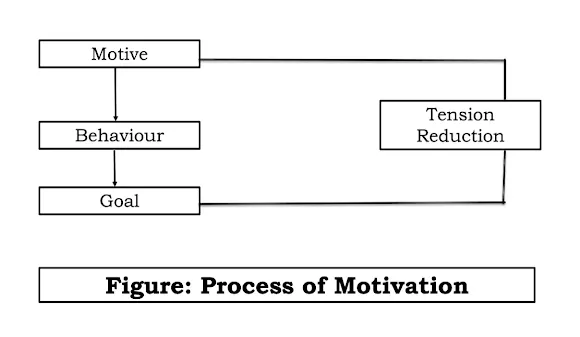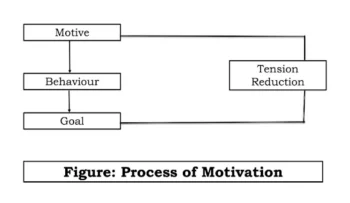Process of Motivation
Motivation is the process of inspiring and stimulating people at the workplace to contribute to the best of their abilities towards achieving organizational goals. The Process of Motivation is one of the important aspects of achieving success in any endeavour. It is an important aspect of any successful business, as it drives employees to perform at their highest level and achieve their goals.
The process of motivation involves various steps as shown in the image:

1) Motive
The process of motivation begins with identifying a motive behind any action. A motive serves as a driving force that stimulates behaviour and provides a reason for it. It is a personal factor that explains a person’s thought process and influences their decision making. Motives keep on surfacing, catalyze behaviour and provide direction to individuals. Motives can vary from person to person and can be influenced by various factors such as beliefs, personal values, and experiences. Identifying and understanding one’s motives can help an individual in achieving personal and professional goals.
Motives are the primary energizer of behaviour and explain the reasons for behaviour. They are largely subjective and represent the mental picture of the individual by explaining the rationale of human behaviour. Motives arise continuously and determine the general direction of the individual’s behaviour.
2) Behaviour
Behaviour is a multifaceted concept which refers to all the activities that an individual performs when he is motivated to achieve personal and organisational goals. The motives of an individual reflect their goals, and sometimes these motives can create an imbalance in their physiological and psychological conditions. Therefore, The behaviour that guides someone towards goal attainment aims to achieve a balance between the two.
The behaviour of an individual is not just limited to actions but also includes thoughts and emotions. Its process is complex and dynamic and is influenced by various internal and external factors. To understand and manage human behaviour effectively, underlying motives and goals must be identified. This can be achieved through feedback from others, self-reflection and analysis of past behaviour routines.
By recognizing and addressing imbalances in physiological and psychological conditions, people can strive towards achieving their goals healthily and sustainably. This not only benefits the people but also contributes to the success of the organization as a whole.
The behaviour of the person comprises a list of actions that he does by being motivated to achieve personal and organisational goals. The individual’s motives are directed towards goals and very often create a state of disequilibrium. These stages of disequilibrium may arise due to the imbalances between the physiological and psychological states of the individual. The behaviour of attaining goals tends to restore balance.
3) Goals
The goal of an individual is influenced by a multitude of factors, including their inherited abilities, cultural and moral values, personal education and experiences, as well as their social and physical environment. These factors play an important role in shaping an individual’s aspirations and directing them towards achieving their desired goals. To effectively support people in achieving their full potential, it is crucial to acknowledge and comprehend the various factors that influence their growth and development.
By setting clear goals, people can focus their efforts and resources towards achieving a desired result. This not only increases the chance of success but also provides a sense of direction and purpose. Hence, it is necessary to establish achievable goals to address any imbalances caused by a motive.
The goals chosen by an individual depend on various factors like cultural norms and values, the individual’s inherited capabilities, the influence of personal learning and experiences, and the level and type of movement in the social and physical world of the employee.
4) Tension Reduction
In an organisation, employees often experience motivational urges as a result of the cultural environment and the pressure to achieve their goals. These urges affect the employee’s perception of their job as well as their personal and professional life. To reduce this tension, organizations need to create a positive and supportive work culture that encourages employee growth and development.
This can be achieved through steady communication, recognition of employee achievements, and by providing opportunities for training and advancement. By fostering a culture of support and growth, organizations can not only reduce tension but can also improve overall productivity, and success and increase employee motivation. To achieve long-term success organizations must prioritize the well-being and development of their employees.
Every individual in the organisation tends to develop certain motivational drives as a product of the cultural environment in which he lives and his goal-driving behaviour. This also affects the way individuals view their jobs and approach their personal and professional lives.
You may also like:
Impact of Globalisation on International Business
Importance of International Business Environment
Complexities of International Business
Multinational Companies Meaning and Definition
Modes of Entry into International Business
Impact of media on consumer Behaviour
Impact of social media on consumer behaviour
Factors Influencing Consumer Behaviour
PsychoanalyticTheory of Perception
Difference between consumer and customer
